SPUD APPEAL
One potato. Two potatoes, three potatoes, four? Nope.
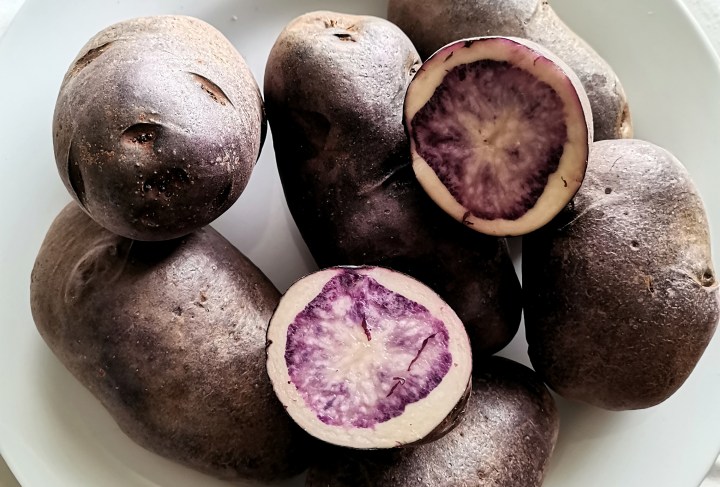
We want a wider choice of potatoes in South Africa. And we want more than one variety to be available. Now.
The counting rhyme goes on: … six potatoes, seven potatoes, more! That’s wishful thinking for us. We do have two more “special” and more expensive potatoes, so we have seven that are highly regarded by SA Potatoes, which would once have been the Potato Board. Of those cultivars, I challenge you to find any other than Sifra on most days at your greengrocer or supermarket. I also challenge you to make half-decent mash with one of the six varietals that isn’t a “special” or “Woolies” varietal, the golden Nicola. The other “special” one is the red-skinned Apache, but it isn’t a masher.
I was invited to a fine dinner given by the chef school side of Pretoria University, for the Potato Board. That part of the university is really the Department of Consumer and Food Sciences, the Food Management section headed by Dr and Chef Hennie Fisher. I desperately wanted to be there. I hoped to find out why we are stuck without the choices of potatoes other countries have. I’m not imagining that we can all grow the same potatoes in our different parts of the world, but we do seem to have surprisingly little to work with here. It’s the complaint of all our chefs and cooks, and of many families.
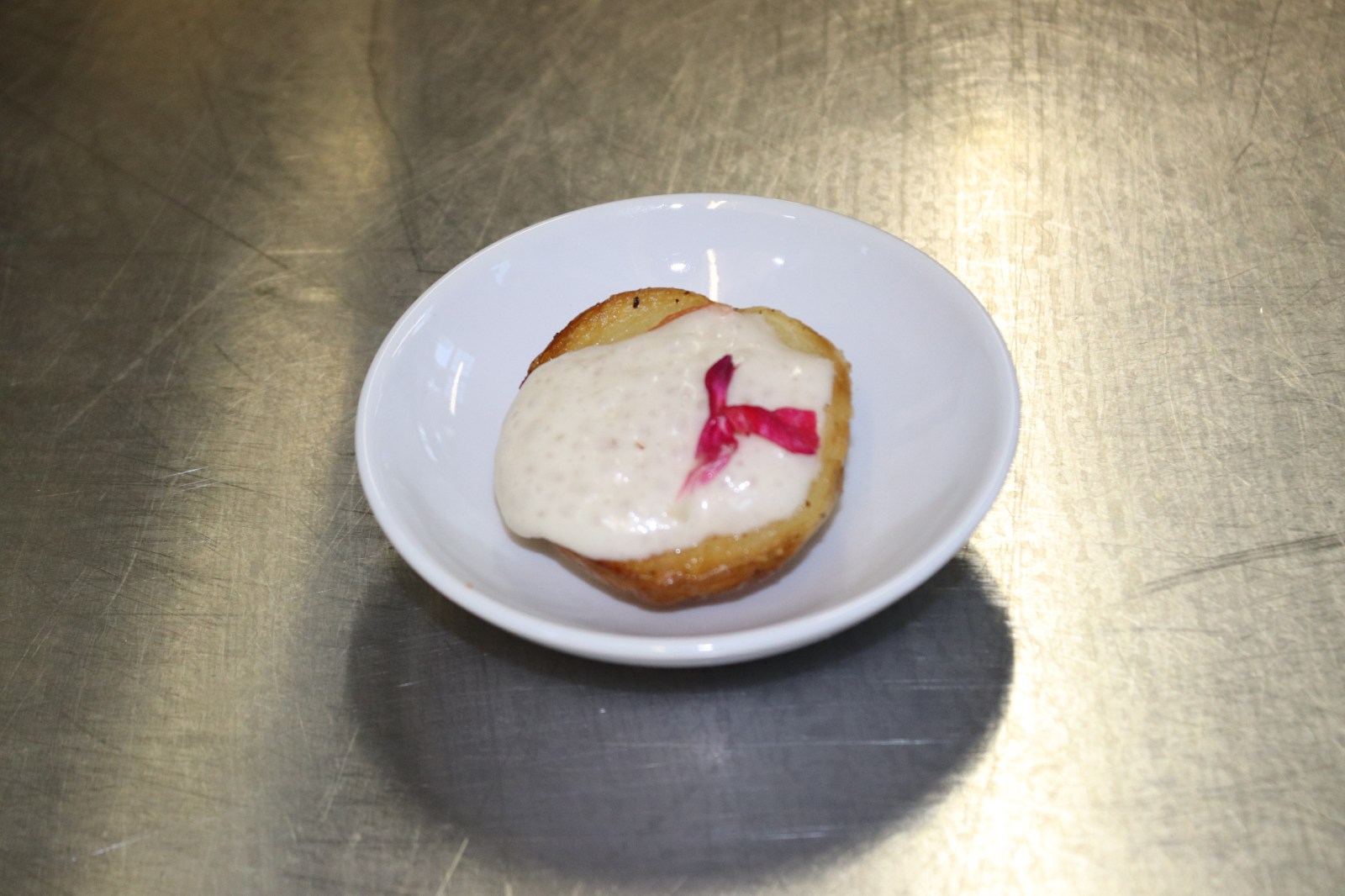
They’re crisped-up potatoes, with creamy potato fillings that get spume-gunned onto smoked trout. (Photo: Supplied)
I stand toying, on a quite warm Pretoria evening, with a cool rosemary vodka cocktail at the entrance. I like this since the vodka is presumably a potato one. They don’t get detail like that wrong here. Indeed, every course this evening will feature potatoes, and they have five, the major cultivars or varietals, to work with.
There will be five courses so that should be neat, I think, though what is happening is that two varietals are often being used in one course. Bowls of flowers and potatoes are on the tables out here. Out come trays of baby potatoes as snacks, baby Valor potatoes I believe, and, as each is served, it’s spume-gunned in the centre with a creamed Mondial potato espuma. So they’re crisped-up potatoes, with creamy potato fillings on some smoked trout, and they taste astonishingly moreish.
Of course, there’s much more. Indoors, tables are glittering with all the glasses and cutlery to take us through all the wine-matched potato courses.
The potatoes featured this evening are the most common, Sifra, often called Russet for no apparent colour reason inside or out, Mondial, Valor, Foxy (essentially a cross of Sifra and Valor) and Lanorma. Later Dirk Uys, the Research Manager of Potatoes SA, will tell me that there were Nicolas too, but on the evening, I’m unaware of these being used anywhere.
The most prolific potato
The most-produced and sold potato in South Africa is the Sifra, all-purpose so sort-of okay for all uses and not great for any. People, and I mean domestic buyers, like these potatoes because “they look clean and most South Africans prefer white potato flesh”. Uys tells me this and I start realising that we only have ourselves to blame for our boring potatoes. We want them like that. Sifra flesh is blank white. Apart from being called Russet, they are also sometimes called Bianca, for more obvious reasons.
The second most-bought and produced potato in South Africa is Mondial. It’s a bit waxier than the all-rounder Sifra, but nothing exciting.
My mother didn’t seem to buy by varietal but by location. I’d be embarrassed whenever we went into fruit and veg shops. She loved potatoes and used to ask in a stagey voice for “Pietersburg potatoes”. They were even better if a bit caked with soil. In Polokwane these days, the potatoes are Sifra, though I once saw a pile of Mnandi potatoes coated with soil and wished my mother were there.
At the table, I sit among mostly potato farmers, many from Limpopo, the country’s biggest potato-growing province. And on the table is a decor piece of a few potatoes, aptly. I ask the guys around me what varietals they are. They aren’t sure and pass the potatoes to each other. “Are they Sifra?” I ask. “They could be. Or even Mondial. One or the other,” says the farmer opposite me. The others nod.
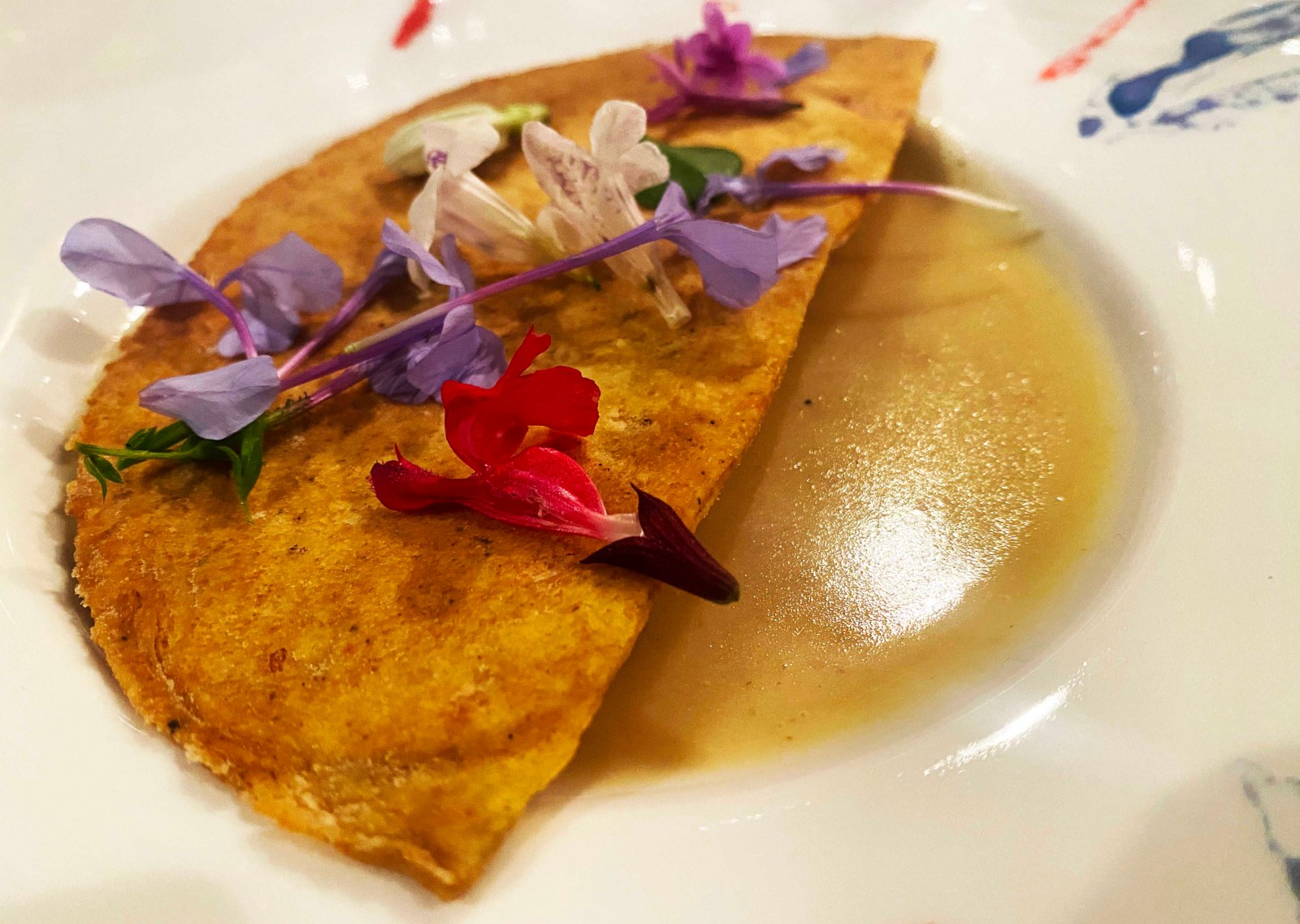
Lightly curried potato soup half-covered by a light and savoury potato cracker. (Photo: Marie-Lais Emond)
The farmers take phone pics to send their apparently – judging by the table reports – gob-smacked wives at home, of the dishes as they appear, the first table course being lightly curried Foxy and Sifra potato soup. Half covering the soup is a light and savoury Valor potato cracker. The dish has even been decorated with potato printing in edible paints. See what I mean about the detail? There’s a four-year-old local Odd Bins rosé champagne matched to it. This surprising kind of combo often seems to work superbly, I’ve come to appreciate.
With chef Hennie is Lerika Potgieter, a final-year student who’s concentrating on potatoes in her final year. I was hoping she’d say that certain potatoes worked best for various ways of cooking them, but she says that they really used any kind for any dish. I get to wondering about our unadventurous choices of potatoes as in my Uys conversation. He is really interested in potatoes and their varietals, I can tell by our food and taste chat.
There are hundreds of cultivars in South Africa, being experimented with and being grown, but only the five basic ones make it into the shops and to the suppliers, for us and for chefs. They are not even that potatoey in taste, except maybe for Lanorma. The two “special” ones, sold at Woolworths alongside the ubiquitous Sifras, are tasty indeed.
The all-rounders
The main five are touted as “all-rounders”. Almost impossibly, we are supposed to be able to boil, bake, chip, mash and roast with them. Mondial is a little waxier than the others but people even use them for chips, though a more slap sort of chip is recommended with Mondial. Apaches also don’t make good chips. Their waxiness and size work against this.
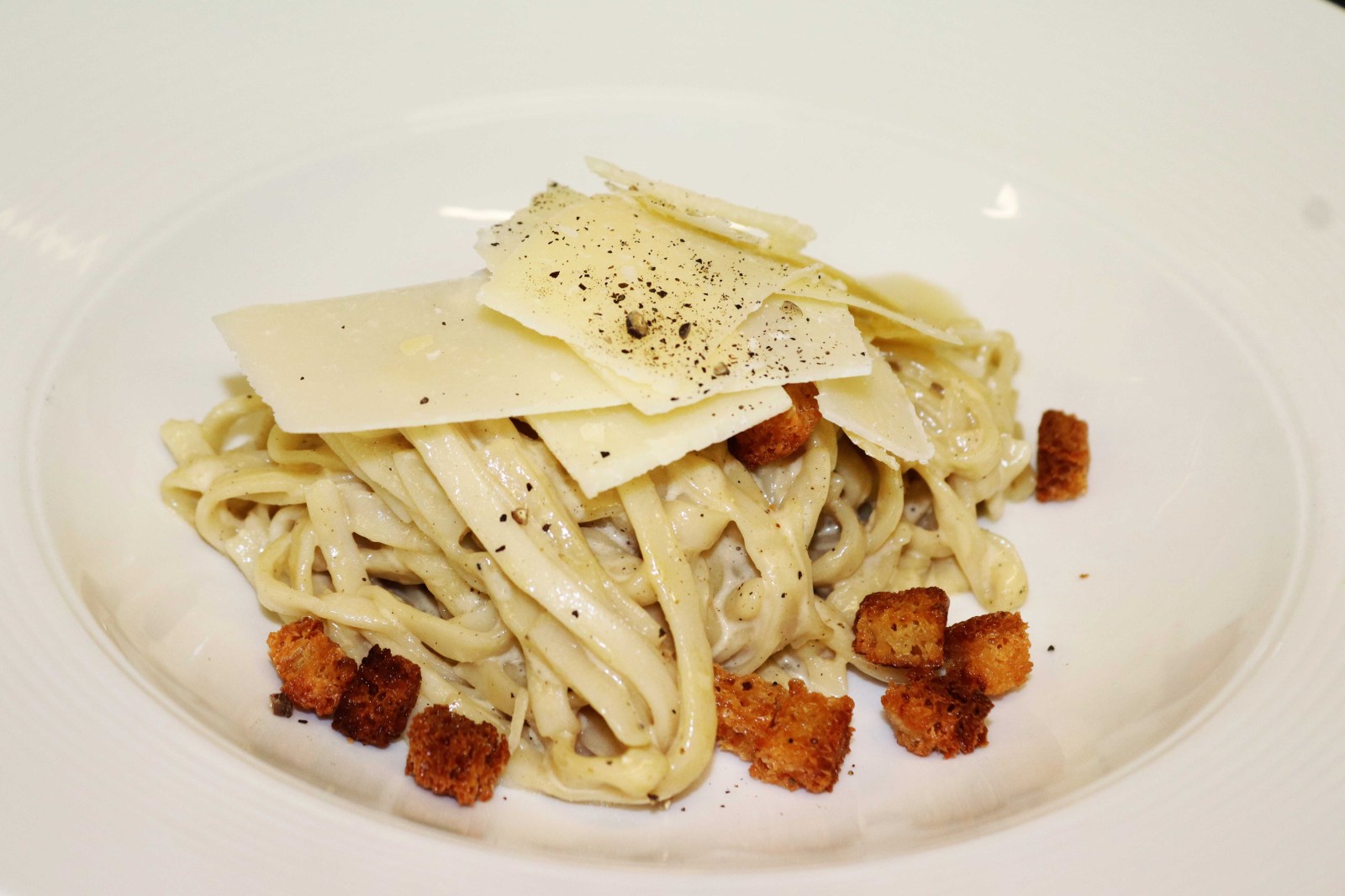
Potato spaghetti, Caesar salad fashion with Parmesan shavings and potato bread croutons. (Photo: Supplied)
The dish coming out of the kitchen now is one made with extruded-from-potato spaghetti in a yummy sort of Caesar salad fashion, with Parmesan shavings and potato bread croutons. Involved in table chatting, I don’t hear which potatoes have been used for the spag or the toast, and I suppose it has stopped being vital to know. I love the dish nevertheless, easily my favourite at the end.
Some of the farmers grow for the big frozen food manufacturers and the crisps market such as Simba. Lays and others have their own potatoes grown for them in South Africa. At my table is a major McCain potato farmer.
Chefs decry our local potatoes and compare them with other so-called second-world countries, like the US and Australia. Most top chefs have cooked around the world and handled its potatoes. One Australian chef of Michelin-starred restaurants, Russell Armstrong, said, “The choice is appalling in South Africa. The people involved, from the growers to the wholesalers, are not interested in which varieties are best suited for whichever culinary processes. Obviously, potatoes are seasonal but in other countries there are 30 or so lovely, easily available spuds to choose from. I try asking for more particular varieties but I’ve been told: ‘It seems okay for everyone else.’ In particular, there is no potato here that’s good for mash.”
Armstrong says he has to make other plans for mash, like baking potatoes on a salt base, and turning them every 25 minutes. He scrapes out the drier innards and adds butter or smoked cream.
I’ve also asked chef James Diack, who is lucky to be able to source almost all his fresh foods from his family farm Brightside. From it, he supplies Basalt, his latest fine dining restaurant in Melrose, and Il Contadino, his Italian food restaurant in Parktown North. Diack laughs about growing potatoes at Brightside because his pigs, free to roam as they are, would destroy the place. “Imagine!” Potatoes are perhaps the only ingredient he doesn’t get from his farm, and he says, “In SA we’re super-limited for choice so I just use average-size potatoes. The bigger they are, the more watery. I’ll give you my special mash recipe to cope with the potatoes we have.” (scroll to the end)
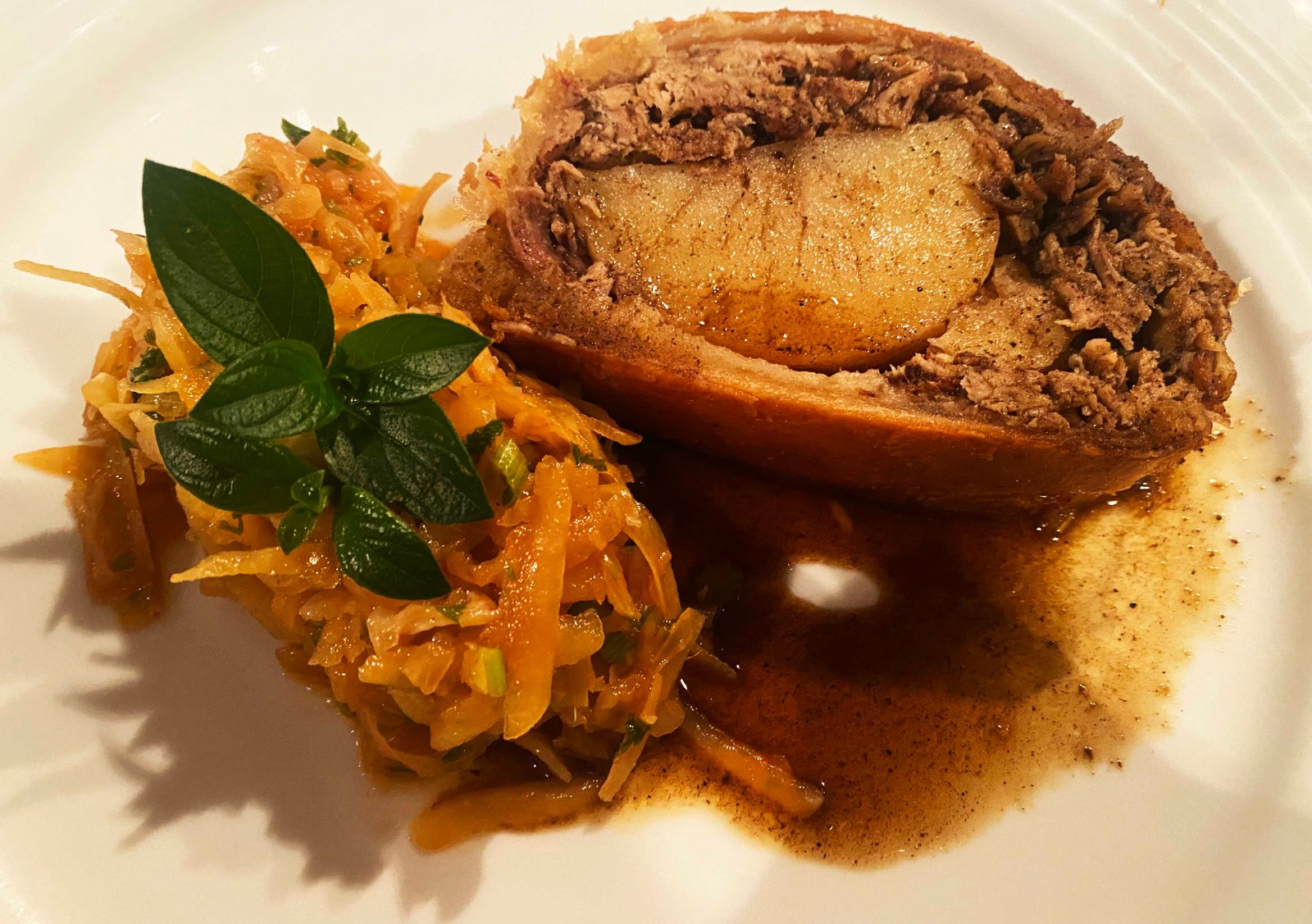
I think it’s very clever, a potato Wellington. (Photo: Marie-Lais Emond)
Our next course, I think, is very clever. It’s a potato Wellington, using the plain old Sifra potato inside as the hero. Between the potato and the crust is Asian-styled, luscious pulled pork. Beside it on the plate is cabbage kimchi.
I wonder while I’m eating what my food-farming friend Siphiwe Sithole of African Marmalade would be growing. She likes to grow foods of the African continent and often just seeds things from ingredients she has tasted. She has both “blue and pink” potatoes. The blue ones could be Congo Blues and the pink ones are not like Apache but, as she says, she can’t keep up with demand. She is mentoring a young woman farmer to grow them too. When I talk to her next I tell her about South Africans wanting, actually wanting, the plain white Sifras and their ilk. She tells me that Malawians, on the other hand, always rather cook with coloured potatoes. “Those potatoes are loaded with more nutrients than the white ones.”
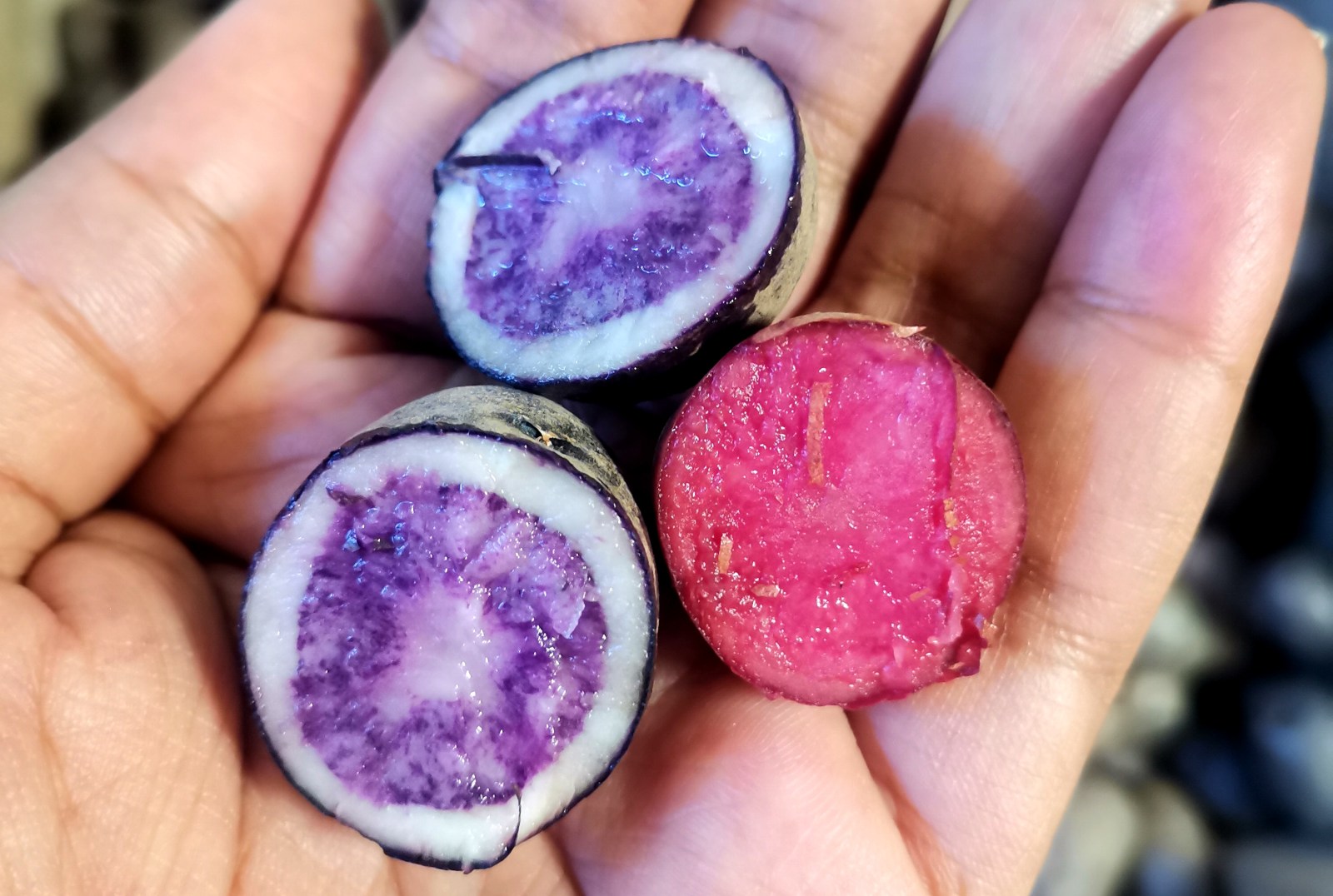
“Those potatoes are loaded with more nutrients than the white ones.” (Photo: African Marmalade)
I’ve also been watching supermarkets to see which potatoes sell and how they are sold. Woolworths make much of their top-end more flavourful and more colourful Nicolas and Apaches. However, the Sifras are there too. Sifra potatoes are in all these places, even the more boutiquey ones. At Tyrone Fruiterers, they are sold in blue bags and red bags, but only the bags are different. The potatoes inside are Sifra. I realise that, at Checkers, with those Sifra potatoes we seem to be so fond of, we are sold different packs. The bags all contain Sifra but one says they’re for “Boil and Roast”, another for “Mash and Bake” and yet another for “Chips”.
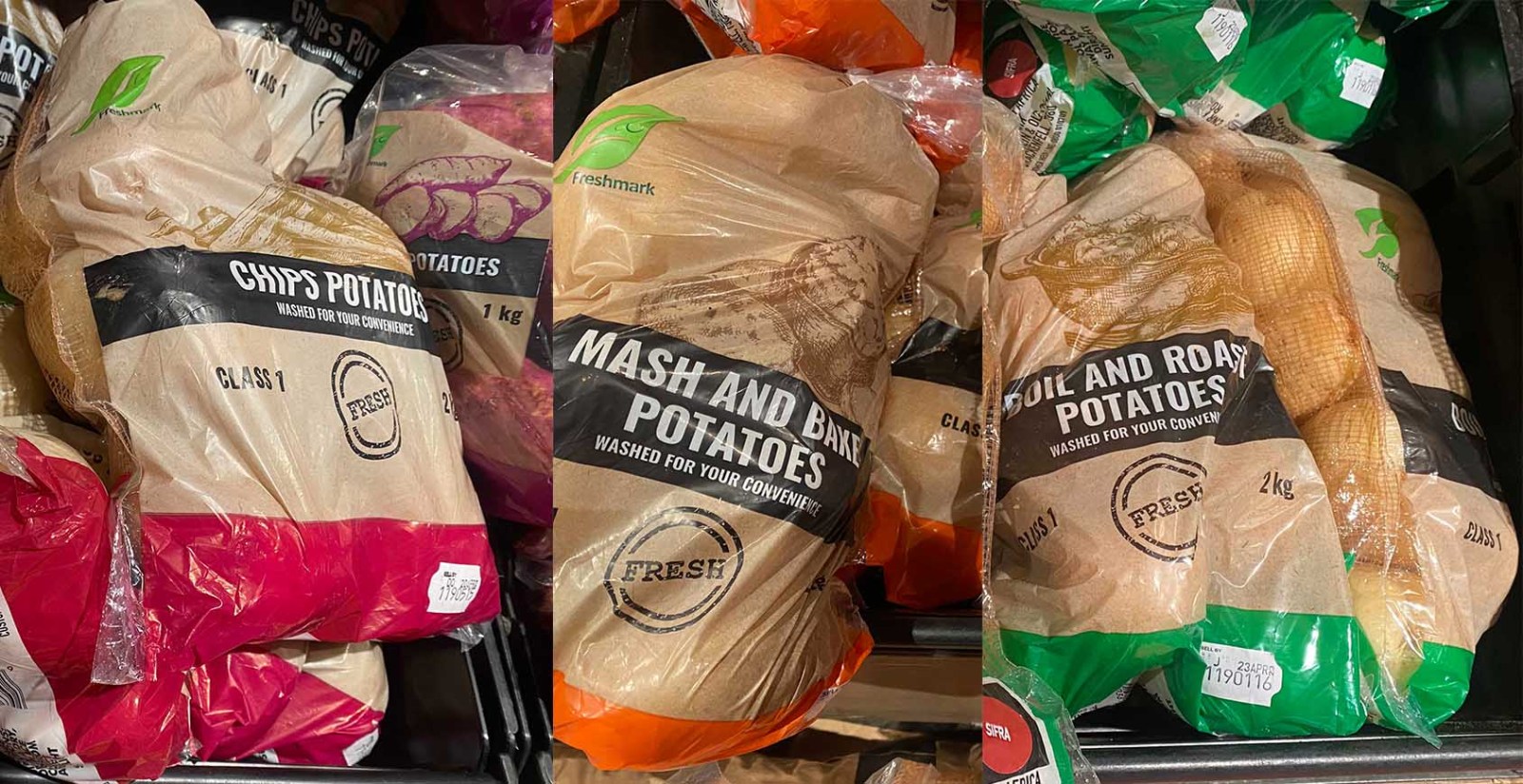
The bags all contain Sifra potatoes, but one says they’re for “Boil and Roast”, another for “Mash and Bake” and yet another for “Chips”. (Photo: Marie-Lais Emond)
The last course at the potato dinner uses potatoes three ways. The plate contains classic Lanorma potato doughnuts glistening with sugar and cinnamon, next to vanilla potato ice cream with a caramel sauce and stewed peaches. Perhaps the thing that delights most people at the dinner, besides the ice cream, is a cream and brown layered Dalgona iced coffee that’s being served at the same time, made with (Foxy) potato milk.
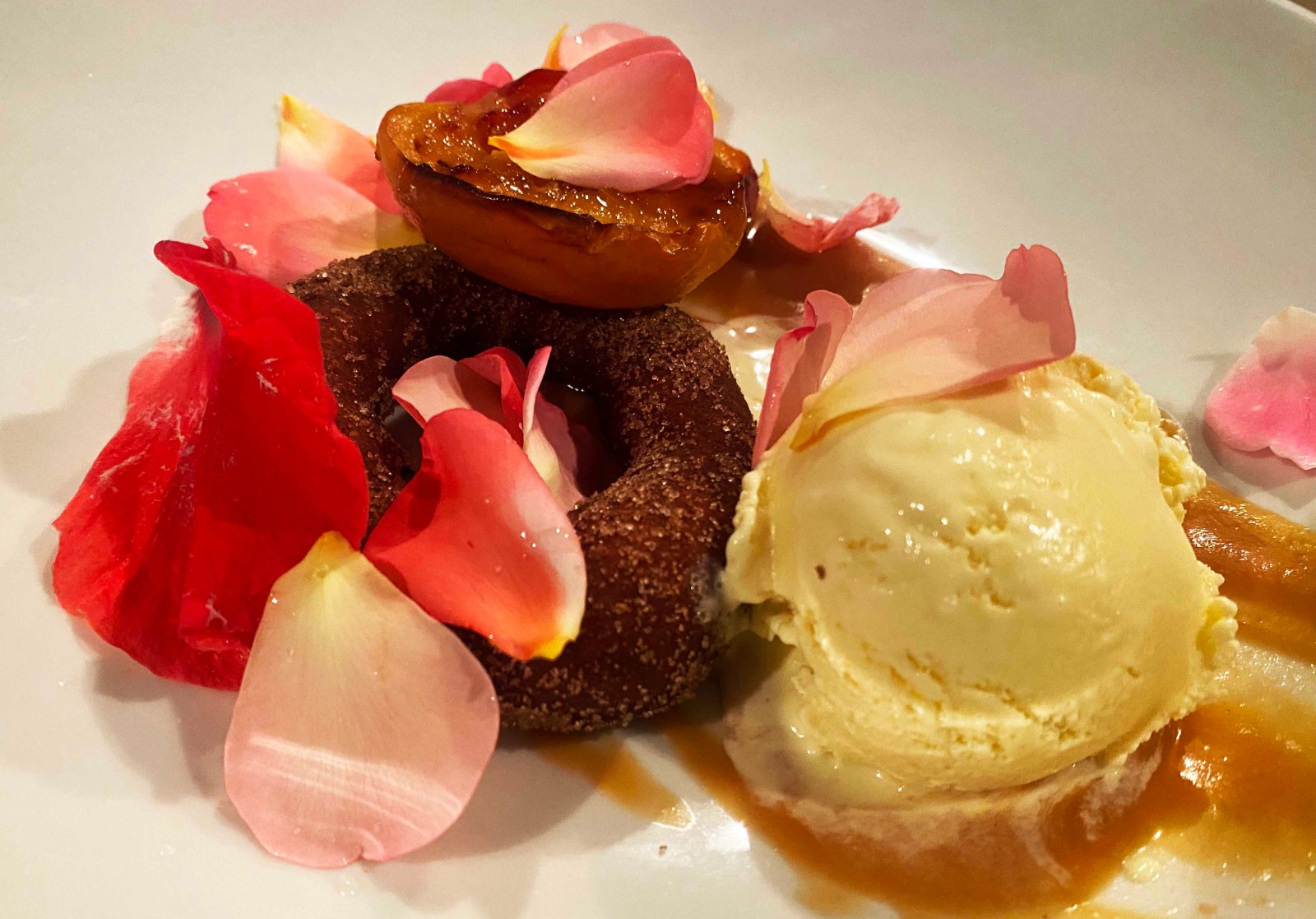
The plate contains classic potato doughnuts next to vanilla potato ice cream with a caramel sauce and stewed peaches. (Photo: Marie-Lais Emond)
“What?!,” I hear, amplified. This course brings the house down.
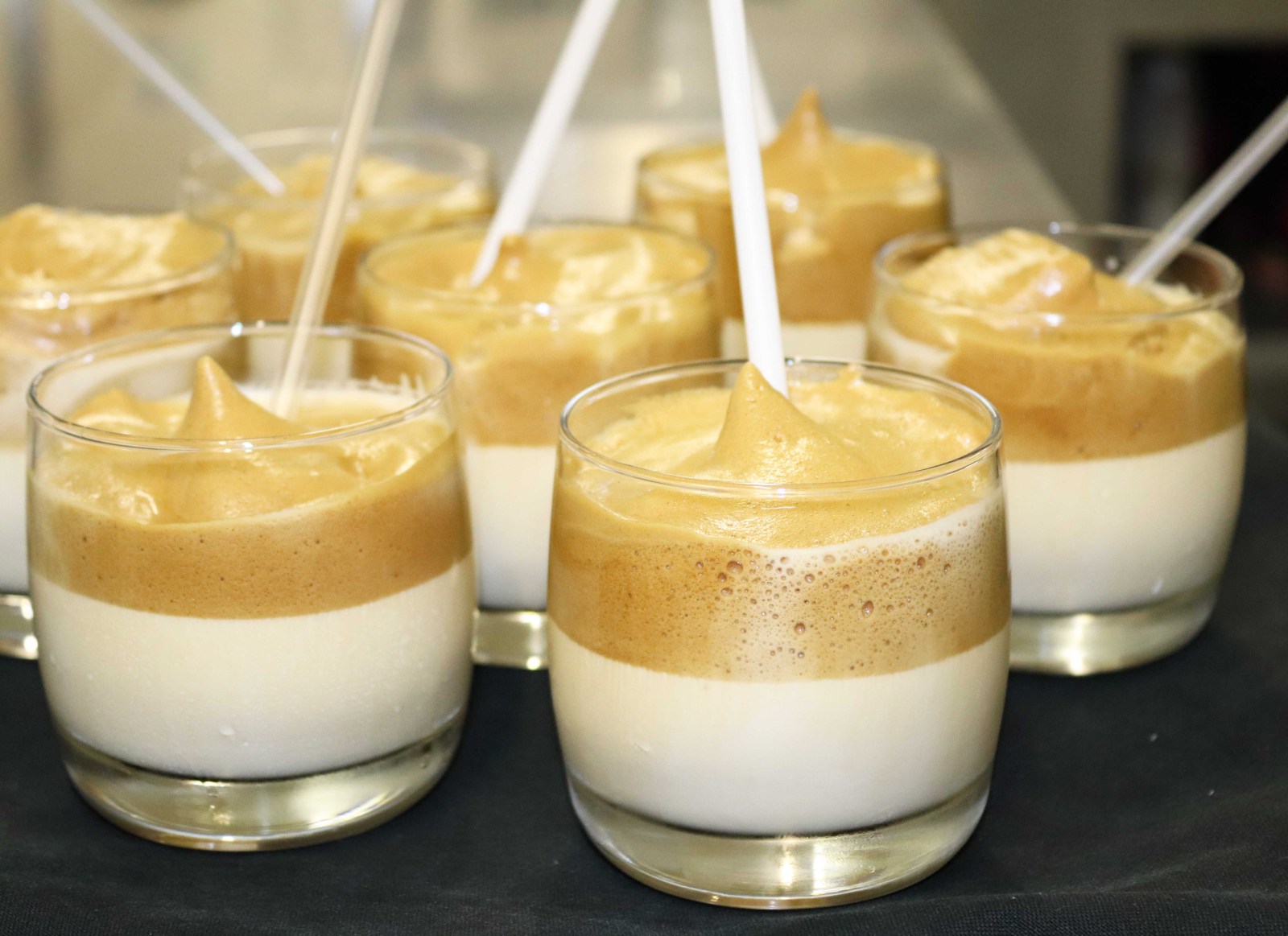
Layered Dalgona iced coffee that’s served at the same time, made with potato milk. (Photo: Supplied)
More potato excitement please
It seems a pity to me, and I have been told that most people seem to think differently about this, that we cannot have more potato excitement and variety for cooking. This Pretoria University dinner has taken huge ingenuity to produce brilliance from less than brilliant potato ingredients. How would we know what we as cooks or chefs can do, what we can ultimately taste, if we don’t get availed of good potato offerings?
Siphiwe of African Marmalade thinks the white, clean thing is all about making chips. The taste is not necessarily important to most South Africans because “the chips will be loaded with chip spice, tomato sauce and other gunk. They’re not even nutritious like that. It’s a bad food choice.” Siphiwe is all about nutrition and natural, organic local farming. “Eat the potatoes with the skin on, preferably, whatever their colour. Find out how delicious potatoes really are without all the add-ons.” She recommends that we South Africans add the purple and pink potatoes to our seven-colour Sunday meals.
We hope to reach the More part of the last line: Five potatoes, six potatoes, seven potatoes… and many more.
Chef James Diack’s mashed potatoes
Use 6 medium-sized potatoes (they’ll almost certainly be Sifra)
Take 3 of them. Peel and cut them into blocks. Boil until soft in salted water.
Pour into a colander and drain them completely.
Mash them.
Place the other 3 potatoes on a tray with the bottom covered in rock salt, and roast them until soft.
Cut them in halves and scoop out the flesh. Mix that flesh in with the other mash.
Force the combined potato mixture through a sieve, using a silicone spatula or the back of a wooden spoon.
You’ll have a super-smooth mash that’s not at all gluey.
Season with salt and pepper and unsalted butter.
Tip: “If you’re making gnocchi, don’t do the boiling part, just the roasting part for the requisite mash, using all 6 potatoes.” DM/TGIFood
Food Management, Dept of Consumer and Food Sciences, Faculty of Natural and Agricultural Sciences, University of Pretoria: 012 420 3780
Potatoes SA: 012 349 1906
Siphiwe Sithole, African Marmalade organic farming business: 072 232 1174
Russell Armstrong, Hospitality consultant chef 072 298 1141
James Diack, Basalt Restaurant 011 537 9797
The writer supports Nosh Food Rescue, an NGO that helps Jozi feeding schemes with food “rescued” from the food chain. Please support them here.






 Become an Insider
Become an Insider
oh yes yes yes! I lived in dublin for a year and was totally confused about which potatoes to buy! I just ended up with the boring “SA-like” ones in most cases. They had a glorious purple skinned one – quite delicious and far superior in my humble opinion
Love potatoes,I also want more varieties, yes,yes,yes
Yes, I’ve been moaning about this lack of choice for years.